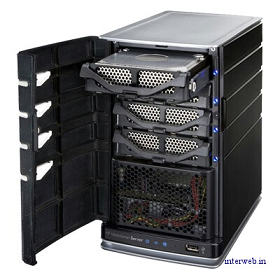Hello, everyone! It’s great to be back in the hot seat for this, our third installment of The Linux Experiment. I know that last time I caused a bit of a stir with my KDE-bashing post, so will try to keep it relatively PG this time around.
Not many people know about it or have used it, but – through an employee purchase program about five years ago – I was able to get my hands on the HP EX470 MediaSmart Home Server. What manner of witchcraft is this particular device, you may ask? Here’s a photo preview:
It really is about as simple as it looks. The EX470 (stock) came equipped with a 500 GB drive, pre-loaded with Windows Home Server – which in turn was built on Windows Server 2003. 512 MB of RAM and an AMD Sempron 3400+ rounded it off; the device is completely headless, meaning that no monitor hookup is possible without a debug cable. The server also comes with four(?) USB ports, eSATA, and gigabit ethernet.
My current configuration is 3 x 1 TB drives, plus the original 500 GB, and an upgraded 2 GB DIMM. One of the things I’ve always loved about Windows Home Server is its ‘folder duplication’. Not merely content to RAID the drives together, Microsoft cooked up an idea to have each folder able to duplicate itself over to another drive in case of failure. It’s sort of like RAID 1, but without entirely-mirrored disks. Still, pretty solid redundancy.
Unfortunately for me, this feature was removed in the latest update to Windows Home Server 2011 – and support for that is even waning now, leading me to believe that patches for this OS may stop coming entirely within the next year or two. So, where does that leave me? I’m not keen to run a non-supported OS on this thing (it is internet-connected), so I’m definitely looking into alternatives.
Over the next few days, I plan to write about my upcoming ‘adventures’ in finding a suitable Linux-based alternative to Windows Home Server. Will I find one that sticks, or will I end up going with a Windows 8 Pro install? Only time will tell. Stay tuned!


Here, I wrote this a few years ago and never looked back
http://www.howtogeek.com/63253/upgrade-your-windows-home-server-with-amahi/
Spoiler alert: I’ve definitely seen this! According to the Amahi site, there are some ‘challenges’ in getting it up and running on a headless box with Ubuntu 12.04 – but I’m definitely looking into it. Awesome article!@Justin Garrison
The idea behind Amahi is probably the good one, but I think ssh is a better and more versatile option than a web server : making a bootable disk with ssh access enabled on another linux machine, and put it in place of the boot disk on the server would be my first attempt.
Anyway, good luck for your test !
Amahi 7 (Fedora based) comes out today. I haven’t looked at it yet but will be once I get a chance to buy new hardware. I also plan to run it on top of XenServer hypervisor so I can run other VMs at the same time. It’s a great product. @Dana H
Hi.. just a question, do you still have the original Recovery disk for your EX470? I came here looking to load an O/S on mine but I really wanted to use the original recovery, but I either misplaced it or tossed it.. (second not likely as I am as anal as hell) but if you don’t, how do you like the linux software on your EX470? thanks a ton.
Kris 😉 have a good one 😉
Hi Kris, thanks for your question – and for making me realize that I had yet to post a follow-up to this. I ended up unloading the EX470 (and all of its discs – sorry!) and tossing the drives into what used to be my home theatre PC; it’s running Windows 8.1 with a big Storage Space now. I don’t see the ugly UI, since it’s only used for file slinging.